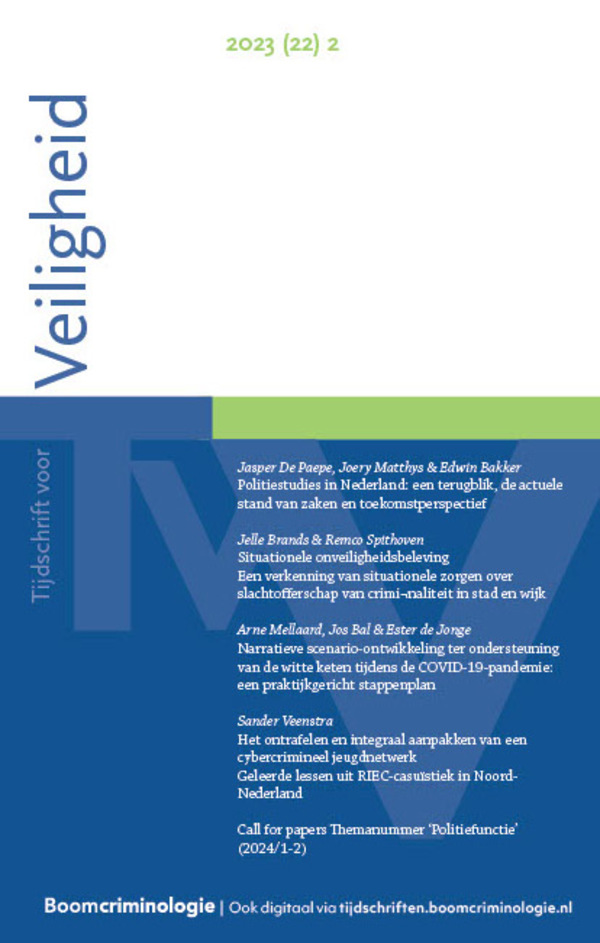|
Surveillance measures in public places such as train stations, large events or business premises are aimed at increasing security at those specific locations. They enable people to move around securely at public (high) risk locations. However, people often experience these measures as an obstacle. Too much security often results in limitations of freedom of movement and violations of privacy. Could surveillance measures be designed in such a way that they are perceived more as a ‘service’? The authors studied the variables that influence whether people experience surveillance as a service or as a hindrance. At three surveillance locations (Schiphol Airport, Hoog Catharijne shopping area and Amersfoort railway station) more than thousand visitors were surveyed. They were asked how they experienced service and security on the site. The results show that there are differences in service perception in relation to security measures at the three locations studied. They show how the tension between service and safety can be reduced and provide clues for improving security measures. The results can be used by owners of public locations, surveillance stakeholders or private companies for the optimalisation and re-design of a location, as their goal is to attract loyal visitors, who are not frustrated and are willing to use the location frequently, and who preferably speak positively about the location to others. Also the security measures themselves can be improved, both technical security measures as well as human security measures. |


Tijdschrift voor Veiligheid
Meer op het gebied van Criminologie en veiligheid
Over dit tijdschriftMeld u zich hier aan voor de attendering op dit tijdschrift zodat u direct een mail ontvangt als er een nieuw digitaal nummer is verschenen en u de artikelen online kunt lezen.
| Artikel |
Gaan veiligheidsmaatregelen ten koste van de servicebeleving? |
| Trefwoorden | customer experience, service perception, surveillance measures, legitimateness |
| Auteurs | Rick van der Kleij, Maaike Roelofs en Dianne A. van Hemert |
| SamenvattingAuteursinformatie |
| Artikel |
Automatische gedragsanalyse voor effectiever cameratoezicht in de openbare ruimte |
| Trefwoorden | Behavior analysis, Threat detection, Action recognition, Tracking, Re-identification |
| Auteurs | Dr. Henri Bouma, Drs. Jeroen van Rest, Dr. ir Gertjan Burghouts e.a. |
| SamenvattingAuteursinformatie |
|
To improve security in crowded environments, such as airports, shopping malls and railway stations, the number of surveillance cameras (CCTV) is rapidly increasing. However, the number of human operators remains limited and only a selection of the video streams can be observed. This makes it hard for an operator to be proactive. This paper gives an overview of novel developments that may lead to more efficient camera surveillance and a more proactive role for camera operators. It focuses on three main steps in this process of video content analysis: pedestrian tracking, action recognition and behavior analysis. Tracking and re-identification (i.e. recognizing a person in another camera) was initially only evaluated on off-line benchmark datasets, though recently it has gained in maturity with live demonstrations in realistic crowded environments and measured improved operator efficiency. For action recognition and automatic behavior recognition, we observe that the simple patterns, such as loitering detection, are emerging in many applications. Human action recognition obtains very high performance values in controlled environments and it is progressing towards more realistic environments. More advanced approaches, such as pickpocket recognition in a shopping mall and the detection of threats to trucks on a parking lot have been developed and the first systems have been presented in live demonstrations. Our main contribution is that we structure the recent advances and the emerging applications of video analysis for security applications, explain and interpret the results, and identify opportunities for the near future. |
| Artikel |
Jihadgang naar Syrië: een wetenschappelijke benadering |
| Trefwoorden | Jihad, Foreign fighters, Syria, radicalisation |
| Auteurs | Nick Platje Msc |
| SamenvattingAuteursinformatie |
|
This article describes a qualitative inquiry into Dutch people going to Syria for participating in Jihad. The inquiry compares theoretical findings with empirical facts, based on a content analysis and a document analysis, completed with ten depth-interviews. The results show that a combination of scientific findings on radicalisation and foreign fighters explains the jihad movement to Syria partly. The results also show that some factors, which have not recently be examined scientificly, are crucial for the character and extent of the movement towards Jihad. |
| Boekbespreking |
Marokkaan in Europa, crimineel in Nederland |
| Auteurs | Abdessamad Bouabid |
| Auteursinformatie |
